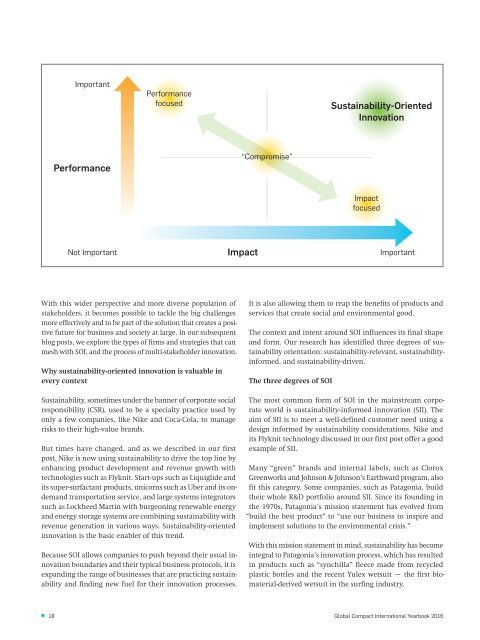Global Compact International Yearbook 2016
The Sustainable Development Goals are an ambitious agenda with 17 topics addressing the global challenges of our time. A key topic is innovation: Business must fit into planetary boundaries. This probably will not work with traditional business models. That is why we need new, fresh ideas. We need change, even when it happens in a rough, disruptive way. And the earlier the better. This is why the upcoming edition of the Global Compact International Yearbook, published in September 2016, has chosen sustainable innovation as the key topic. Also includes exclusive interviews with Angelina Jolie, Robert Redford and Sigourney Weaver. The Global Compact International Yearbook is with more than 500,000 readers one of the worlds leading CSR publications. Münster/New York 2016: 164 pages, paperback Publishing houses: macondo publishing/UN Publications Subscription (via UN Publications only): 30.00 USD (regular) 15.00 USD (reduced) ISBN13: 978-3-946284-01-7 / ISSN-Print: 2365-3396 / ISSN-Internet: 2365-340x
The Sustainable Development Goals are an ambitious agenda with 17 topics addressing the global challenges of our time. A key topic is innovation: Business must fit into planetary boundaries. This probably will not work with traditional business models. That is why we need new, fresh ideas. We need change, even when it happens in a rough, disruptive way. And the earlier the better. This is why the upcoming edition of the Global Compact International Yearbook, published in September 2016, has chosen sustainable innovation as the key topic.
Also includes exclusive interviews with Angelina Jolie, Robert Redford and Sigourney Weaver.
The Global Compact International Yearbook is with more than 500,000 readers one of the worlds leading CSR publications.
Münster/New York 2016: 164 pages, paperback
Publishing houses: macondo publishing/UN Publications
Subscription (via UN Publications only): 30.00 USD (regular) 15.00 USD (reduced)
ISBN13: 978-3-946284-01-7 / ISSN-Print: 2365-3396 / ISSN-Internet: 2365-340x
You also want an ePaper? Increase the reach of your titles
YUMPU automatically turns print PDFs into web optimized ePapers that Google loves.
Important<br />
performance<br />
focused<br />
Sustainability-Oriented<br />
innovation<br />
Performance<br />
“Compromise”<br />
Impact<br />
focused<br />
Not Important<br />
impact<br />
Important<br />
With this wider perspective and more diverse population of<br />
stakeholders, it becomes possible to tackle the big challenges<br />
more effectively and to be part of the solution that creates a positive<br />
future for business and society at large. In our subsequent<br />
blog posts, we explore the types of firms and strategies that can<br />
mesh with SOI, and the process of multi-stakeholder innovation.<br />
Why sustainability-oriented innovation is valuable in<br />
every context<br />
Sustainability, sometimes under the banner of corporate social<br />
responsibility (CSR), used to be a specialty practice used by<br />
only a few companies, like Nike and Coca-Cola, to manage<br />
risks to their high-value brands.<br />
But times have changed, and as we described in our first<br />
post, Nike is now using sustainability to drive the top line by<br />
enhancing product development and revenue growth with<br />
technologies such as Flyknit. Start-ups such as Liquiglide and<br />
its super-surfactant products, unicorns such as Uber and its ondemand<br />
transportation service, and large systems integrators<br />
such as Lockheed Martin with burgeoning renewable energy<br />
and energy storage systems are combining sustainability with<br />
revenue generation in various ways. Sustainability-oriented<br />
innovation is the basic enabler of this trend.<br />
Because SOI allows companies to push beyond their usual innovation<br />
boundaries and their typical business protocols, it is<br />
expanding the range of businesses that are practicing sustainability<br />
and finding new fuel for their innovation processes.<br />
It is also allowing them to reap the benefits of products and<br />
services that create social and environmental good.<br />
The context and intent around SOI influences its final shape<br />
and form. Our research has identified three degrees of sustainability<br />
orientation: sustainability-relevant, sustainabilityinformed,<br />
and sustainability-driven.<br />
The three degrees of SOI<br />
The most common form of SOI in the mainstream corporate<br />
world is sustainability-informed innovation (SII). The<br />
aim of SII is to meet a well-defined customer need using a<br />
design informed by sustainability considerations. Nike and<br />
its Flyknit technology discussed in our first post offer a good<br />
example of SII.<br />
Many “green” brands and internal labels, such as Clorox<br />
Greenworks and Johnson & Johnson’s Earthward program, also<br />
fit this category. Some companies, such as Patagonia, build<br />
their whole R&D portfolio around SII. Since its founding in<br />
the 1970s, Patagonia’s mission statement has evolved from<br />
“build the best product” to “use our business to inspire and<br />
implement solutions to the environmental crisis.”<br />
With this mission statement in mind, sustainability has become<br />
integral to Patagonia’s innovation process, which has resulted<br />
in products such as “synchilla” fleece made from recycled<br />
plastic bottles and the recent Yulex wetsuit — the first biomaterial-derived<br />
wetsuit in the surfing industry.<br />
18<br />
<strong>Global</strong> <strong>Compact</strong> <strong>International</strong> <strong>Yearbook</strong> <strong>2016</strong>

















